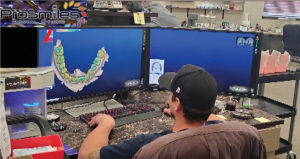Editor’s intro
Dr. Justin Moody sings the praises of the digital lab for facilitating minimally invasive surgery and precision placement. Read about his experience here.
Dr. Justin D. Moody discusses the digital possibilities for minimally invasive surgery and precision placement

In the past, I have talked about how nearly every dental laboratory is digital in some way. Last month I had just finished a guided surgery case that made implant dentistry seem way too easy, so I decided to go and check out the lab that fabricated it. What I found is far beyond just a digital scan, beyond a computer screen, or the fancy 3D-printed models.
True digital workflow exists in today’s premier labs; they embrace it, and when you talk with the technicians, you would find that they actually thrive on it. Jeremy Herbert at ProSmiles Dental Studio is the CAD/CAM department supervisor and captain of the U.S.S. Molar, their new digital design center. He walked me through the process for making a surgical guide. It’s truly all digital, all virtual, and 100% amazing, in my opinion. Many times the fabrication of immediate-loaded restorations that were placed with a guide can be done at the same time of guide manufacture, and this saves the office time and patient visits, and is just cool to see. Virtual articulators that help make the connection from the patient to the 3D screen are no longer theory but reality. I personally use the Kois Facebow, which allows the information to be transferred to the CAD/CAM software. This wasn’t even talked about years ago when I first learned from Dr. John Kois.

Surgical guide cases arrive at the lab in two parts — the .dcm file from the CBCT and the .stl file from the surface scan. Jeremy and his team of design artists take these files and merge them using surgical guide software, and with guidance from the treating doctor, they prepare a concept guide based on their desired outcome. Once the doctor has signed off on the guide design, it goes to the 3D-printing department for fabrication, processing, and finishing. Many of the guides require metal sleeves specific for the guided kits. The use of only authentic OEM parts is critical for the proper seating, positioning, and placement of the planned implants.
The final product is packaged up with the guide protocol sheets and overnighted to the final destination. How long does all this take? This mainly depends upon the doctor providing all the data as soon as possible, providing a clear restorative plan, and timely review of the concept for proof. Normally this can take just days in the lab, and as technology improves, so does the turnaround times and the quality of the product. Today’s implant dentistry is so exciting — there’s better treatment done with minimally invasive surgery and precision placement for prosthetically driven results!




Editor’s call to action
Working with a digital lab is just one of Dr. Moody’s secrets. Watch the DocTalk Dental podcast where he shares his dental secrets with Publisher Lisa Moler. https://implantpracticeus.com/doctalk-dental/doctalk-dental-dr-justin-moody/.
Stay Relevant With Implant Practice US
Join our email list for CE courses and webinars, articles and mores

 Justin D. Moody, DDS, DABOI, DICOI, is a Diplomate in the American Board of Oral Implantology, Diplomate in the International Congress of Oral Implantologists, Honored Fellow, Fellow, and Associate Fellow in the American Academy of Implant Dentistry, and Adjunct Faculty at the University of Nebraska Medical Center. He is an internationally known speaker, founder of the New Horizon Dental Center (nonprofit clinic), and Director of Implant Education for Implant Pathway. You can reach him at
Justin D. Moody, DDS, DABOI, DICOI, is a Diplomate in the American Board of Oral Implantology, Diplomate in the International Congress of Oral Implantologists, Honored Fellow, Fellow, and Associate Fellow in the American Academy of Implant Dentistry, and Adjunct Faculty at the University of Nebraska Medical Center. He is an internationally known speaker, founder of the New Horizon Dental Center (nonprofit clinic), and Director of Implant Education for Implant Pathway. You can reach him at 

